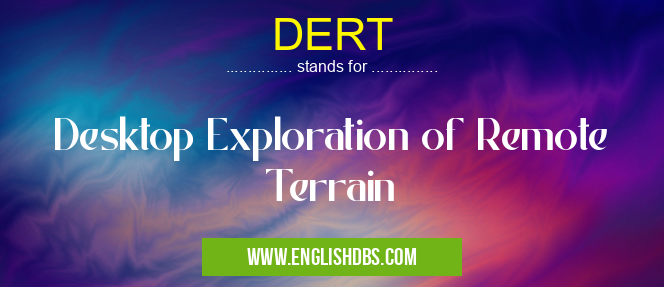What does DERT mean in UNCLASSIFIED
DERT stands for Desktop Exploration of Remote Terrain. It is a software application used to explore and analyze elevation data, terrain models, and other geospatial datasets. DERT provides a virtual environment for users to navigate and visualize data, extract information, and perform geospatial analysis.

DERT meaning in Unclassified in Miscellaneous
DERT mostly used in an acronym Unclassified in Category Miscellaneous that means Desktop Exploration of Remote Terrain
Shorthand: DERT,
Full Form: Desktop Exploration of Remote Terrain
For more information of "Desktop Exploration of Remote Terrain", see the section below.
Key Features
- 3D Visualization: DERT allows users to view terrain data in a realistic 3D environment, enabling them to better understand the topography and spatial relationships.
- Data Exploration: Users can navigate through the terrain, zoom in and out, rotate the view, and change the lighting to gain different perspectives and insights.
- Data Analysis: DERT offers tools for measuring distances, slopes, and other terrain parameters. It also allows users to overlay multiple datasets, such as elevation data with geological maps, to identify patterns and correlations.
- Terrain Modeling: DERT can generate terrain models from elevation data, which can be used for further analysis and visualization.
- Data Sharing: Users can export terrain models, images, and other data for sharing and collaboration.
Applications
DERT has applications in various fields, including:
- Geoscience: Geological mapping, hazard assessment, landform analysis
- Environmental Science: Watershed delineation, erosion modeling, habitat suitability assessment
- Planning and Management: Site selection, infrastructure planning, resource extraction
- Education: Teaching geospatial concepts and terrain analysis
Benefits
- Enhanced Data Understanding: DERT provides a more intuitive and immersive way to visualize and explore terrain data, leading to a deeper understanding of spatial relationships and patterns.
- Improved Decision-Making: By providing accurate and comprehensive terrain information, DERT supports informed decision-making in various fields.
- Time-Saving: The ability to navigate and analyze data quickly and efficiently saves time and effort compared to traditional methods.
- Increased Collaboration: DERT facilitates data sharing and collaboration among users, enabling multidisciplinary approaches to geospatial analysis.
Essential Questions and Answers on Desktop Exploration of Remote Terrain in "MISCELLANEOUS»UNFILED"
What is Desktop Exploration of Remote Terrain (DERT)?
DERT is a technique that allows scientists and researchers to explore and study remote and inaccessible areas on Earth using high-resolution satellite imagery and other geospatial data. This enables them to conduct detailed observations and analysis without physically visiting the locations.
What are the benefits of using DERT?
DERT offers several benefits:
- Cost-effectiveness: It significantly reduces the expenses associated with field expeditions, which can involve transportation, lodging, equipment, and safety measures.
- Accessibility: DERT allows researchers to access remote areas that would otherwise be difficult or impossible to reach due to geographical constraints or safety concerns.
- Time-saving: DERT enables rapid data acquisition, reducing the time required for field surveys and observations.
- Non-invasive: DERT does not disturb or damage the environment, making it an environmentally friendly research method.
What types of data can be collected using DERT? A: DERT enables the collection of a wide range of data, including: Remote sensing imagery: Satellite images provide detailed information about land cover, vegetation, soil types, and geological features. Geospatial dat
DERT enables the collection of a wide range of data, including:
- Remote sensing imagery: Satellite images provide detailed information about land cover, vegetation, soil types, and geological features.
- Geospatial data: Geographic Information Systems (GIS) software allows researchers to integrate and analyze multiple data layers, such as topography, hydrology, and land use.
- Digital elevation models (DEMs): DEMs provide precise elevation data, enabling the creation of topographic maps and terrain models.
- Field observations:Researchers can supplement DERT with field observations from accessible areas to validate satellite data and provide ground truth information.
What are the applications of DERT?
DERT has various applications across multiple disciplines:
- Geology: Mapping of geological formations, identification of mineral resources, and hazard assessment.
- Ecology: Wildlife habitat analysis, biodiversity assessments, and conservation planning.
- Geography: Land use planning, environmental impact assessments, and disaster response.
- Hydrology: Water resource management, flood mapping, and drought monitoring.
- Archaeology: Identification and exploration of archaeological sites, cultural heritage preservation.
Final Words: DERT is a powerful tool that enables users to explore, analyze, and visualize terrain data in a virtual environment. Its features and applications make it a valuable resource for geoscientists, environmental scientists, planners, and others involved in geospatial analysis. By providing a better understanding of terrain and spatial relationships, DERT contributes to informed decision-making and advances various fields of study and practice.
